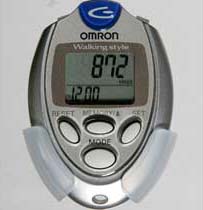|
Pedometer: a nifty gift for all walks of life
Sunday, December 9, 2007
Evra Taylor Levy and Eddy Lang, Special to the Gazette
A cheap and simple device may be able to reap enormous benefits through an important lifestyle change. This instalment of HealthWatch looks at the evidence for pedometers as a way of promoting physical activity as well as the specifics of how to make them work.
Canadians are experiencing an inactivity crisis - so says Participaction, and their strident declaration is accurate when one considers that more than 25 per cent of children age 2 to 17 are overweight, and another 8 per cent are obese.
For those of us who have kids, more upsetting still is a New England Journal of Medicine report that "our children's lifespan could be two to five years less than our own."
A pedometer keeps track of how much walking you do and can even encourage you to improve your fitness.

Marcos Townsend / The Gazette |
More than half of Canadians are considered inactive and the repercussions are tremendous. People who are overweight or obese face a higher risk of developing heart disease, stroke, cancer, diabetes, liver disease, depression, infertility, and such birth defects as spina bifida. What's more, while other factors affect the incidence of these diseases and conditions, excess body weight alone increases risk.
And although we've made significant strides in reducing disease and death linked with cardiovascular disease, lack of physical activity threatens to mitigate this improvement.
Making strides toward greater health
For something that costs so little but promises such great benefit, you'd think exercise would be a no-brainer: Regular physical activity is associated with as much as a 30-per-cent reduction in deaths from all causes.
A healthy dose of physical activity also reduces the risk of cardiovascular disease, the fatigue experienced by cancer patients undergoing treatment, osteoporosis (weight-bearing exercise, in particular, strengthens bones), Type 2 diabetes, obesity, and high blood pressure. On a psychological level, it relieves depression, stress and anxiety by releasing mood-lifting endorphins.
With the benefits of research no longer in doubt, medical researchers are now focusing on ways of getting us off the couch.
The study
Using pedometers to increase physical activity and improve health, by Dean M. Bravata et al., Journal of the American Medical Association, Nov. 21, 2007.
What kind of study was this?
The authors of this trial conducted a kind of research called a systematic review. In this kind of study, researchers work closely with health librarians to scour the world literature and find all of the studies that answer a specific question.
What question did they want to answer?
The goal of the study was to see what are the health benefits of wearing a pedometer. Specifically, they wanted to see whether pedometers motivate people to be more physically active, and whether as a result of this increase in exercise they might see benefits in terms of lower blood pressure and decreased obesity. They were also interested in seeing if the pedometer alone resulted in these benefits or if its use had to be coupled with a goal-setting program - i.e. the need to log 10,000 steps per day.
The researchers reviewed the results of 26 studies that recruited more than 2,700 patients, most of whom were women and who were sedentary, and many of whom were battling health issues of some kind, like diabetes or chronic lung disease related to smoking or high blood pressure.
So, what did the study show?
Wearing a pedometer resulted in an average increase in walking of more than 2,000 steps per day compared with the comparison groups, amounting to a difference of more than 2 kilometres. Not only that: the pedometer group also saw a reduction in body fat as measured by their Body Mass Index and a reduction in blood pressure.
Of note, too, is that the greatest increases in physical activity were seen in studies where the pedometer programs were coupled with a specific daily objective in terms of steps. Surprisingly, older patients (over 60 years old) showed the most impressive effects across all these benefits.
Wait a minute, how do we know that the comparison group was less active if they didn't have pedometers?
Actually, they generally wore pedometers as well, but theirs were sealed shut so that they couldn't keep tabs on what they were doing.
How does wearing a pedometer work to make you more active?
The study doesn't answer this question specifically, but a number of people, including pedometer users, noted that wearing a pedometer motivates them to make sure that they meet their daily step count objective.
For example, if by late afternoon, someone is at only 7,000 steps, they might get off the subway one stop early and walk until the 10,000 step mark is reached.
People are somewhat competitive by nature. It's natural, therefore, to want to check your pedometer at the end of the day to see how you did and try to beat your previous record.
Is a pedometer a worthwhile investment?
Absolutely. Reliable devices are easy to find and cost about $10. At this time of year, we buy well-thought-out special items for the ones we love. What better gift than something that shows how much you care about a loved one's health? If people are motivated by this simple device to become more active, they'll reap the benefits of a pedometer-based activity program: better health, a greater sense of well being, and possibly even more time with their precious family.
We wish to thank Steven Grover, director of McGill's Cardiac Health Improvement Program for his input in this column.
*The material provided in Healthwatch is designed for general educational purposes only and does not pertain to individual cases. The information included should not replace necessary medical consultations with your own doctor or medical professional.*
© The Gazette (Montreal) 2007
|


